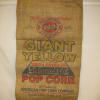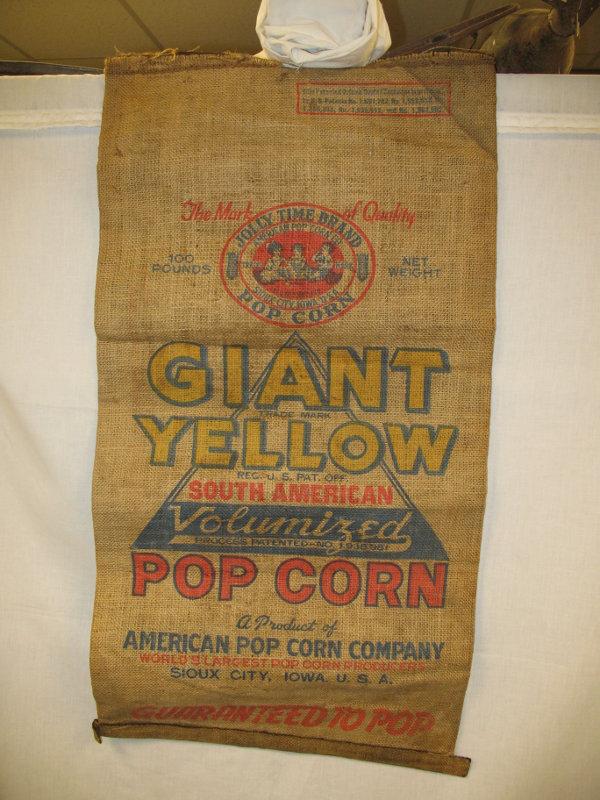Harvesting Corn
| Grade | 4th Grade | Class | Social Studies | Length of Lesson | 40-45 Minutes |
| Lesson Title | Harvesting Corn |
| Unit Title | Follow the Kernel |
| Unit Compelling Question | How does Iowa corn impact Iowa and the world? |
| Historical Context: The history of corn goes back over 10,000 years. Native Americans brought corn up the Mississippi River to Iowa. The corn plants were very small at the beginning but over centuries, cultivation by Native Americans and scientists have changed corn. Harvesting corn has changed also. It took Native Americans almost twenty hours of man-labor for each bushel of corn they harvested, but now a farmer can produce a bushel of corn in about six minutes. Iowa grows, on average, nearly 183 bushels of corn per acre. Tractors and technology allow corn to be grown, processed, and marketed all over the world. ~Allyson Simpson, Simpson College 2018.046.007 This sack was used by the American Pop Corn Company to ship popcorn to movie theaters. The American Pop Corn Company was founded in Sioux City, Iowa by Cloid Smith in 1914, making it the oldest popcorn company in the United States. The company, which created Jolly Time popcorn, used several methods to ship and sell popcorn directly to consumers and in stores. The company often used sacks like this one, which held 100 pounds of popcorn, to sell popcorn to theaters because the theaters needed large amounts of popcorn and often sold it rather quickly. Living in Odebolt, Iowa and owning a telephone company, Cloid Smith decided in 1912 to sell the business to the Bell Telephone Company and buy farming land in Odebolt. With the crops grown, Smith started a business of packaging and selling popcorn. Since popcorn was not sold in stores and could only be bought in bulk, in the first year, 75,000 bags were sold and the brand name "Jolly Time" began to gain popularity. As the business grew and Smith realized corn popped better after being dried and aged for a year, a new building was built to store up to 500,000 pounds of corn. The popcorn was sold to buyers in either cellophane bags or metal tins- a first for any popcorn company. In addition to popcorn, buyers could also purchase salt, cartons and popping oils sold by the company. During the Great Depression, the company charged only a dime for popcorn, a price that people could still afford and kept business going. When Smith died in 1939, his son Howard took over the business. During the year of his death, the company sold only 10-ounce tins of popcorns per Smith's wishes. Today, the company is still running, operated by the fourth and fifth generation of the Smith family. |
|
| Lesson Supporting Question | |
| Lesson Overview | Students will look at how corn was harvested "long ago" in 1939 by analyzing a primary source. They will then compare that to how corn is harvested now thinking about the benefits and drawbacks toward each. |
| Primary Sources Used |
|
| Resources Needed | |
| Standard | |
| Lesson Target | Students will compare harvesting corn "long ago" versus "now" using pictures and their prior knowledge finding 3 similarities and 3 differences. |
| Lesson Themes | Early Agriculture, Farmers/Farm Life |
|
| Formative Assessment (How will you use the formative assessments to monitor and inform instruction?) |
Assess by looking at the students comparisons between the two types of harvesting. Also during students discussion walk around to listen to conversations and how they are determining their thoughts. |
| Summative Assessment (How does the lesson connect to planned summative assessment(s)?) |
This is the first lesson in a set of lessons to get students to answer the compelling question. A summative assessment will be completed at the end of the unit. |
| Author | Sarah Barry | Created | Last Edited | ||||
| Reviewer: Dr. Chad Timm, Simpson College | |||||||
| Lesson Plan Development Notes: Social Studies Methods, Simpson College, Spring 2019 | |||||||


